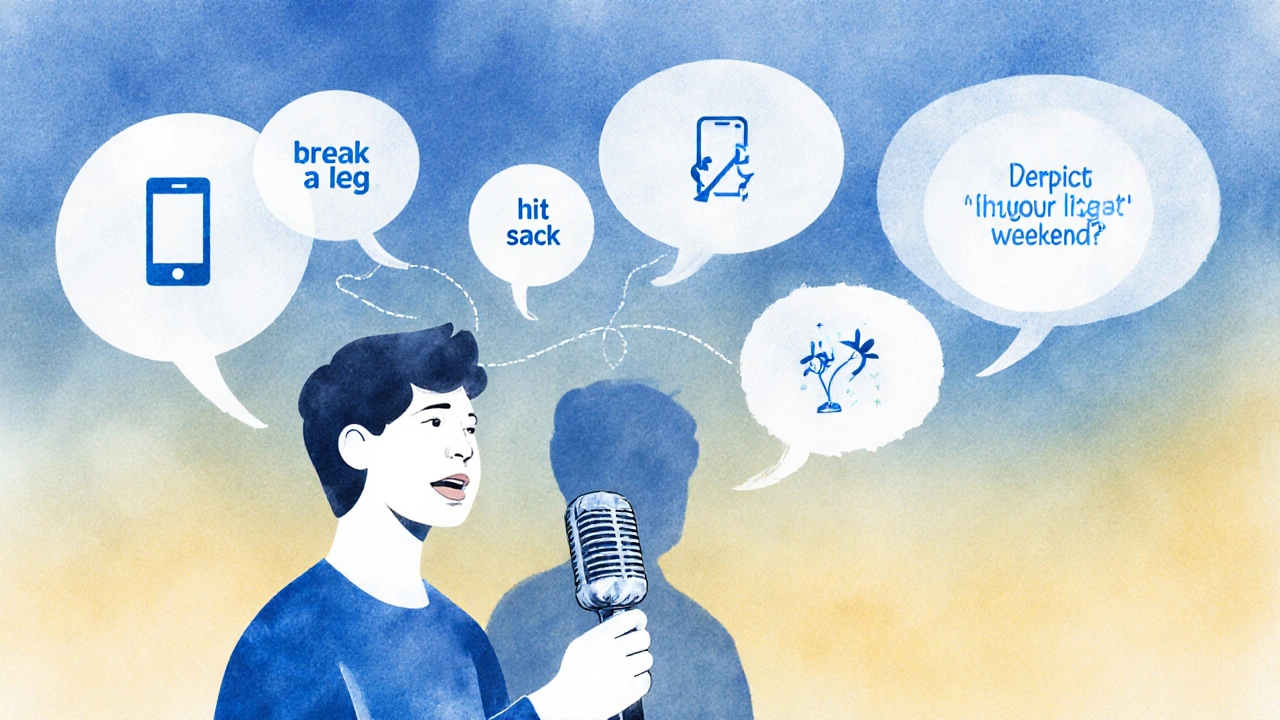Where Can I Learn English Speaking for Free? Top Realistic Options in 2025
 Nov, 25 2025
Nov, 25 2025
Speaking Practice Calculator
Track Your Speaking Progress
See how your daily practice builds toward fluency. Based on the article's research, consistent practice (even 10 minutes daily) leads to real results.
Want to speak English confidently but don’t want to spend a dime? You’re not alone. Millions of people around the world are learning to speak English for work, travel, or personal growth - and many of them are doing it without paying for a single class. The truth is, you don’t need expensive tutors or fancy programs to get good at speaking English. You just need the right tools, a little discipline, and a plan.
YouTube Channels That Actually Teach You to Speak
YouTube isn’t just for cat videos and music clips. It’s one of the most powerful free resources for learning spoken English. Channels like English Addict with Mr Steve and Learn English with Emma break down real conversations into simple, digestible lessons. They don’t just teach grammar - they show you how people actually talk.
Mr Steve, for example, runs daily 10-minute videos where he speaks naturally, then slows down to explain phrases like “I’m gonna grab a coffee” or “What’s up?” You can pause, repeat, and mimic his tone. After three weeks of watching just 10 minutes a day, learners report noticing a real difference in how quickly they respond in conversations.
Don’t just watch - talk along. Record yourself repeating what they say. Compare your voice to theirs. It feels awkward at first, but that’s how your mouth learns new muscle patterns. This isn’t passive learning. It’s active practice.
Free Language Exchange Apps
Apps like Tandem and HelloTalk connect you with native English speakers who want to learn your language. You spend 30 minutes teaching them your language, and they spend 30 minutes helping you speak English. No cost. No contracts. Just real people.
One user in Toronto, Maria, started using Tandem to practice English while helping a student in Brazil learn Portuguese. Within two months, she went from nervous and hesitant to holding 20-minute conversations about movies, work, and her cat. She didn’t memorize grammar rules - she learned by asking questions like, “How would you say this in English?” and getting instant feedback.
Tip: Don’t wait until you feel “ready.” Start when you’re unsure. Most native speakers don’t mind mistakes - they appreciate the effort. Send a voice note instead of typing. Hearing your own voice helps you catch pronunciation errors you wouldn’t notice in writing.
Podcasts Designed for Learners
Listening is key. But not just any listening. You need content made for learners, not native speakers. Try ESLPod or English as a Second Language (ESL) Podcast. These aren’t news shows or comedy routines. They’re built for people like you.
Each episode is around 10-15 minutes. They cover everyday topics - ordering coffee, making small talk, understanding accents. The hosts speak slowly, repeat key phrases, and explain idioms like “break a leg” or “hit the sack.” You can download episodes and listen while walking, commuting, or doing dishes.
Here’s how to make it work: Listen once for general understanding. Listen again and write down three new phrases. Then say them out loud five times. Do this for 10 days, and you’ll start recognizing those phrases in real life - on TV, in stores, or in conversations.

Public Libraries and Community Centers
Many public libraries in Canada, the U.S., and the U.K. offer free English conversation groups. In Toronto, the Toronto Public Library runs weekly “English Conversation Circles” at over 20 branches. No registration needed. Just show up.
These aren’t classes. They’re casual meetups. A group of 6-10 people sit around a table and talk about anything: weekend plans, favorite foods, recent movies. There’s no test. No homework. Just practice. Volunteers - often retired teachers or bilingual locals - help guide the conversation if people get stuck.
One man in Mississauga started going because he was too shy to speak at work. After six months, his coworkers noticed he was speaking up more in meetings. He didn’t take a course. He just showed up every Tuesday.
Free Online Speaking Practice Tools
Tools like Speechling and ELSA Speak offer free tiers that let you record yourself and get instant feedback on pronunciation. Speechling lets you submit short audio clips and get corrections from real native speakers - not just AI. You get one free correction per day. That’s enough to start improving.
ELSA Speak’s free version gives you access to basic pronunciation drills. It highlights which sounds you’re mispronouncing - like the difference between “ship” and “sheep.” It’s not perfect, but it’s better than nothing. Use it for 10 minutes a day, and you’ll notice your accent becoming clearer over time.
Another free tool: Forvo. Type in any word, and you’ll hear it pronounced by native speakers from different countries. Want to know how an Australian says “tomato”? Or how an American says “schedule”? Go there. Listen. Repeat.
Shadowing Technique: The Secret Weapon
Shadowing is a method used by professional interpreters and language learners who want to sound natural fast. Here’s how it works:
- Find a short audio clip (30-60 seconds) from a YouTube video or podcast.
- Play it once to understand the meaning.
- Play it again, and speak along with the speaker - exactly as they say it. Match their speed, rhythm, and intonation.
- Repeat until you can do it without pausing.
This trains your brain to think in English, not translate from your native language. It’s hard at first. You’ll stumble. But after 15 days of shadowing just 10 minutes a day, you’ll start speaking with more flow. People will say, “You sound more confident.”

What Doesn’t Work (And Why)
Not all free resources are equal. Avoid apps that promise “speak English in 7 days” with flashcards and quizzes. These teach vocabulary, not speaking. You can memorize 500 words and still freeze when someone asks you, “How was your weekend?”
Also skip grammar-heavy websites that focus on past perfect tense or conditionals. You don’t need to know every rule to speak. You need to know how to express yourself - even if it’s not perfect. Native speakers don’t speak like textbooks. They use contractions, slang, and incomplete sentences all the time.
Don’t wait for perfection. Speak anyway. Even if you make mistakes. Every mistake is data. It tells you what to work on next.
How to Build Your Free English Speaking Routine
Here’s a simple weekly plan that works for busy people:
- Monday, Wednesday, Friday: 10 minutes of shadowing (use a YouTube clip or podcast)
- Tuesday, Thursday: 15 minutes on Tandem or HelloTalk (voice chat only)
- Saturday: Watch a 20-minute YouTube lesson and write down 3 new phrases. Say them out loud.
- Sunday: Visit your local library’s English circle - or join an online group on Meetup.com.
That’s less than two hours a week. No cost. No pressure. Just consistent practice.
Real Progress Takes Time - But It’s Possible
There’s no magic button. No app that turns you into a fluent speaker overnight. But if you show up every day, even for five minutes, you’ll get better. People who stick with free methods for six months often reach a level where they can handle job interviews, order food abroad, or chat with neighbors without fear.
One woman from Pakistan moved to Canada and started using free resources because she couldn’t afford classes. After 10 months, she got a customer service job. Her manager didn’t notice her accent - he noticed she was clear, polite, and confident.
You don’t need money. You need momentum. Start today. Speak out loud. Even if it’s just to your dog. Your next conversation is waiting - and you’re already ready to begin.
Can I really learn to speak English for free?
Yes. Thousands of people learn to speak English without paying for classes. Free resources like YouTube, language exchange apps, podcasts, and public library groups give you real speaking practice. Success comes from consistency, not cost. You don’t need to spend money - you need to show up regularly.
What’s the fastest way to improve my speaking skills for free?
The fastest way is to combine shadowing with real conversations. Shadowing trains your mouth and ear to match native speech patterns. Talking with real people - even if you make mistakes - builds confidence and quick thinking. Do both daily for 10-15 minutes, and you’ll see progress in weeks, not months.
Do I need to learn grammar to speak English?
Not the way schools teach it. You don’t need to memorize rules about past perfect tense or subjunctive mood to hold a conversation. Focus on learning phrases people actually use - like “I was just about to…” or “Could you repeat that?” - and practice saying them. Grammar becomes clearer naturally as you hear more English.
How long does it take to speak English fluently using free resources?
It depends on how much you practice. Someone who speaks for 15 minutes a day, five days a week, can reach conversational fluency in 6-12 months. Fluency doesn’t mean perfect grammar - it means you can express your thoughts without pausing to translate. The key is daily exposure and active speaking, not passive learning.
Are free apps like Duolingo good for speaking English?
Duolingo is great for vocabulary and basic structure, but it’s not designed for speaking practice. Its speech exercises are short and often don’t reflect real conversation. Use it as a warm-up, but don’t rely on it. Pair it with Tandem, YouTube, or shadowing for real progress.
What if I’m too shy to speak with native speakers?
Start by talking to yourself. Record your voice answering simple questions like “What did you eat today?” or “Why do you like this movie?” Listen back. Then try speaking to a language partner who’s also learning - they won’t judge you. Most people are too focused on their own mistakes to notice yours. Progress starts with small steps.
Next steps: Pick one free resource from this list - YouTube, Tandem, or your local library - and commit to using it for 10 minutes a day for the next 30 days. Track your progress in a notebook. Write down one thing you learned each day. You’ll be surprised how much you grow.